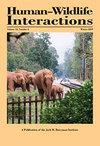印度北部Zanskar地区的人熊冲突和社区风险感知
IF 0.9
4区 环境科学与生态学
Q4 BIODIVERSITY CONSERVATION
引用次数: 0
摘要
喜马拉雅棕熊(Ursus arctos isabellinus)是一种濒临灭绝的棕熊亚种,分布在南亚和中亚的喜马拉雅地区。我们描述了印度北部Zanskar地区与喜马拉雅棕熊的人熊冲突(HBC)的类型和当前水平,并提出了潜在的缓解方法。在2018年7月至9月期间,我们采访了赞斯卡尔地区的218个家庭,他们都经历过HBC。在过去4年中,参与者报告了越来越多的HBC事件。最常见的HBC形式是对储存食物的粮仓的破坏(50%)。由于HBC,大多数参与者说他们害怕熊(95%),不喜欢熊(73%)。然而,95%的参与者认为应该保护喜马拉雅棕熊。我们的结论是,当地居民对熊的保护是接受的,但目前的措施不足以保护财产和牲畜。在印度赞斯卡尔,我们鼓励社区参与熊监测,并安装防熊食品容器、太阳能灯和电围栏,以减少HBC的发病率,培养对熊的容忍。本文章由计算机程序翻译,如有差异,请以英文原文为准。
Human-Bear Conflict and Community Perceptions of Risk in the Zanskar Region, Northern India
The Himalayan brown bear (Ursus arctos isabellinus) is an endangered subspecies of brown bear (U. a. spp.) and is found throughout the Himalayan region of south and central Asia. We describe the type of and the current level of human–bear conflict (HBC) with Himalayan brown bears in the Zanskar region of northern India and suggest potential mitigation methods. Between July and September 2018, we interviewed 218 households across the Zanskar region, all of whom had experienced HBC. Participants reported increasing numbers of HBC events in the last 4 years. The most common form of HBC was damage to granaries where food is stored (50%). As a result of HBC, most participants said they feared bears (95%) and did not like them (73%). However, 95% of participants thought that the Himalayan brown bear should be conserved. We conclude that local people are receptive to bear conservation, but the current measures are insufficient to protect property and livestock. We encourage community involvement in bear monitoring as well as installation of bear-resistant food containers, solar lights, and electric fences to reduce incidences of HBC and foster tolerance of bears in Zanskar, India.
求助全文
通过发布文献求助,成功后即可免费获取论文全文。
去求助
来源期刊

Human–Wildlife Interactions
Environmental Science-Nature and Landscape Conservation
CiteScore
2.80
自引率
0.00%
发文量
0
审稿时长
11 weeks
期刊介绍:
Human–Wildlife Interactions (HWI) serves the professional needs of the wildlife biologist and manager in the arena of human–wildlife conflicts/interactions, wildlife damage management, and contemporary wildlife management. The intent of HWI is to publish original contributions on all aspects of contemporary wildlife management and human–wildlife interactions with an emphasis on scientific research and management case studies that identify and report innovative conservation strategies, technologies, tools, and partnerships that can enhance human–wildlife interactions by mitigating human–wildlife conflicts through direct and indirect management of wildlife and increased stakeholder engagement. Our intent is to promote a dialogue among wildlife professionals concerning contemporary management issues. As such, we hope to provide a repository for wildlife management science and case studies that document and share manager experiences and lessons learned.
 求助内容:
求助内容: 应助结果提醒方式:
应助结果提醒方式:


